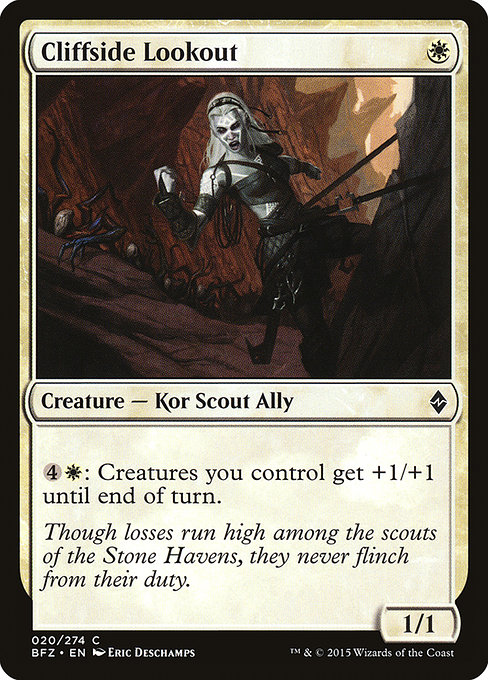
Image courtesy of Scryfall.com
Cliffside Lookout and the Case for Fan-Driven Card Design
Fan engagement in card design isn’t just about shouting “nerd power” into a chat room; it’s about translating playstyle desires, story interests, and mechanical curiosity into tangible, printable ideas. The Battle for Zendikar era gave fans a sandbox where tribal themes, land cycling, and bold combat choices could mingle. A small, white-based creature from that set—a one-drop Kor Scout with a potent late-game pump—offers a surprisingly robust lens for understanding how the community can influence design decisions. The card shows how a simple concept can spark conversations about balance, identity, and the kind of moments players crave in their games 🧙🔥💎⚔️.
At its core, the card embodies white’s traditional strengths: efficient early play, a focus on board presence, and the ability to rally the troops for a decisive moment. With a mana cost of {W} and a body that reads as “one to start, one to buff,” it’s approachable for new players yet flexible enough to enable satisfying midgame swings. The activated ability—{4}{W}: Creatures you control get +1/+1 until end of turn—highlights a common but meaningful white tactic: temporary force multipliers that flip the persistence of a board state into a dangerous tempo play or a sudden blitz in the air. That tension between low cost and temporary power is precisely the kind of space fans love to discuss, because it invites deck-building exploration while keeping the card approachable in draft and sealed formats 🎲.
Design constraints and opportunities
- Tempo versus impact: A 1/1 creature for 1 mana is a gentle start, but the pump ability lets players push a cooperative or proactive plan. Fans naturally imagine ways to maximize tempo—how often you can push more damage or blunt an opponent’s line by buffing a few critters at the right moment. The lesson is that a small, well-timed power spike can be as memorable as a big, splashy spell 💎.
- Color identity and flavor: White’s instinct for defense, community, and fair play is amplified when the buff extends to all creatures you control. This fosters boards that feel cohesive rather than gimmicky and aligns with the flavor of “watchful guardians on the edge” implied by the cliffside setting. Fans often propose variations that could tilt the design toward tempo, go-wide strategies, or stabilizing surprises—without losing the core identity that makes white feel dependable ⚔️.
- Tribal and synergy potential: Although the card isn’t a powerhouse tribal card on its own, its placement in Battle for Zendikar’s broader Allies theme invites fans to imagine stronger tribal support within the white ecosystem. The concept sparks discussions about how a well-timed pump could interact with other allies or token producers, inviting designers to explore synergy clusters that feel both thematic and mechanically expressive 🎨.
- Rarity and accessibility: As a common with a foil option, Cliffside Lookout demonstrates how a card can be easy to draft around yet still produce meaningful play experiences. Fan ideas often center on how to preserve accessibility while creating memorable gameplay moments—an ongoing balancing act for set designers, especially in limited formats where everyone wants to feel smart for discovering a clean line of play 💎.
Flavor, art, and audience participation
The flavor text—“Though losses run high among the scouts of the Stone Havens, they never flinch from their duty.”—paints a vivid narrative of duty under pressure. Fans respond to this kind of storytelling by proposing alt-art variants, lore-driven companion cards, or flavor tweaks that deepen the world without shifting the card’s core mechanics. Eric Deschamps’ illustration channels that sentinel vibe: a watchful Kor on a windy ledge, eyes scanning the horizon for threats or opportunity. When players bond with a card’s story as tightly as its mechanics, the line between strategy and lore blurs in the coolest way. This is the essence of fan-driven design in action: ideas born from play patterns and worldbuilding converging into a product that feels inevitable once you see it in action 🧙🔥🎨.
“Design is where game language meets story, and the best cards translate both into a moment you can remember and a choice you want to repeat.”
What fans often champion is not merely more power, but more meaningful play moments. A card like this invites players to think about timing, synergy, and the emotional beat of a turn where a single buff turns a timid board into a formidable force. In the larger design conversation, it illustrates how accessible frames with room to grow can welcome a wide audience into the dialogue about what makes a card shine. The community’s role isn’t just critique; it’s co-creation—dreaming up the what-ifs that designers can test in future sets 🧩.
From dream to deck-building reality
In practical terms, fans envision a spectrum of possibilities: a go-wide white archetype with cheap creatures, a token-production engine that benefits from temporary boosts, or a protective, board-preserving build that leverages a quick swing to close out games. Cliffside Lookout serves as a focal point for these discussions because its core idea—granting temporary communal power—translates cleanly across formats, whether it’s the fast tempo of Modern or the more casual, communal rhythms of Pauper or Commander. In player-driven design conversations, the question isn’t just about “how strong is the effect?”; it’s about “how does this impact the feel of the game, the trajectory of a match, and the story we tell every time we sit down to play?” 🧙🔥
For readers who want to immerse themselves further in MTG culture while enjoying practical gear for long sessions, check out the product link below. It’s a playful reminder that the hobby isn’t only about cards—it’s about the entire table, the snacks, the stories, and the glow of a well-set board as you roll dice and draft dreams 🎲.